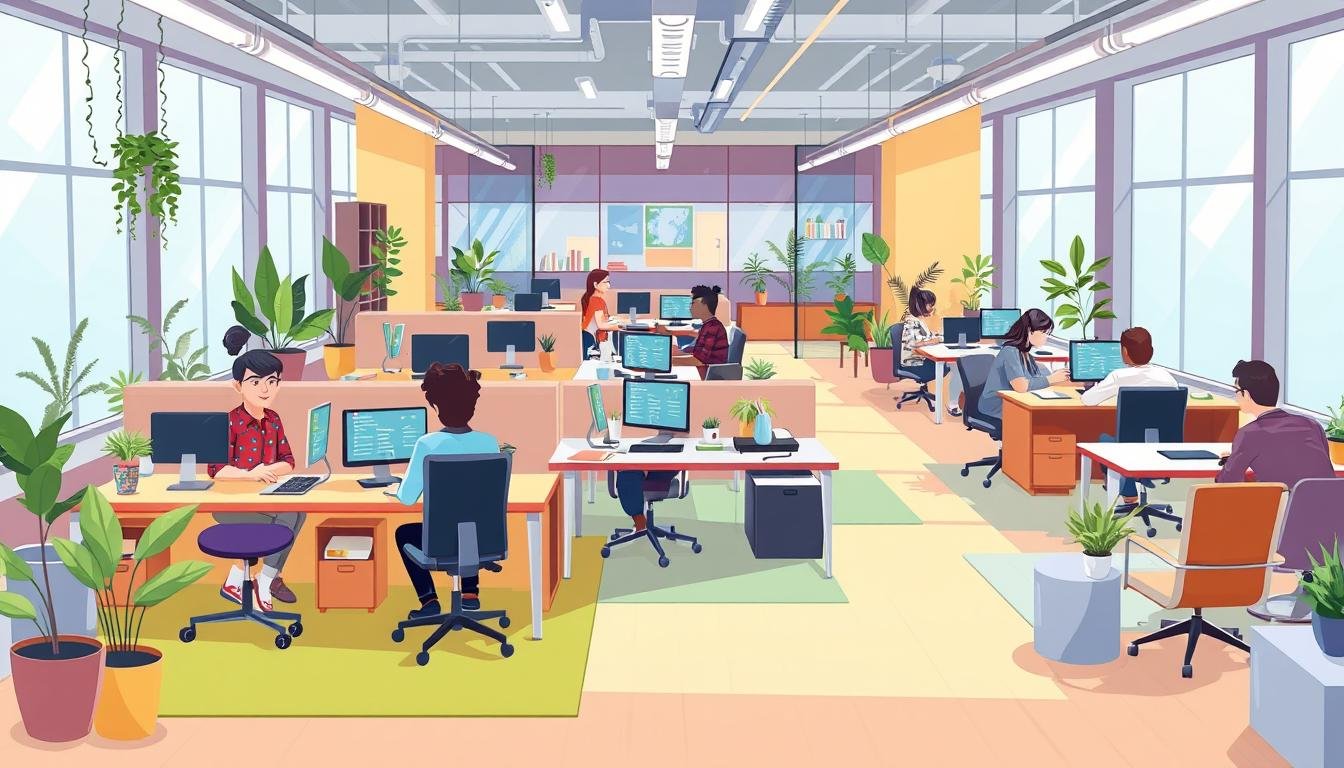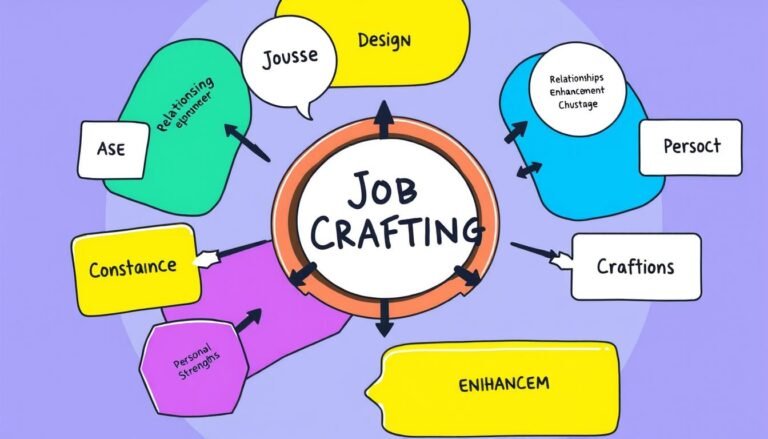Workplace Flexibility: The Psychology of Designing an Adaptable Workforce
Is the traditional 9-to-5 office routine becoming outdated? Workplace flexibility is changing how we see work and productivity. With the rise of remote work and hybrid models, we’re seeing a big shift in how companies operate.
The idea of an adaptable workforce is now key, especially after COVID-19. Now, flexibility means working from home or adjusting schedules easily. This change is more than a trend; it’s a big shift in work-life balance and employee happiness.
Studies show that flexibility greatly improves job satisfaction and reduces stress. For example, working from home boosts job satisfaction by 65%. Being able to change your schedule can cut job stress by 20%. These numbers highlight the growing role of flexible work in today’s business world.
As we dive into the psychology of adaptable workforces, we’ll see how these changes affect workers and companies. From keeping talent to designing workspaces, flexibility’s impact is wide and changing everything.
Key Takeaways
- Remote work and hybrid models are reshaping traditional work structures
- Flexible work arrangements can significantly boost job satisfaction
- Workplace flexibility impacts employee stress levels and well-being
- Adaptable workforces are becoming crucial for organizational success
- The COVID-19 pandemic has accelerated the adoption of flexible work practices
The Evolution of Work Organization Practices
Work organization has changed a lot in recent years. This is due to changes in the population, new technology, and what employees want. Now, we see more flexible work hours and workers having more control over their jobs.
Demographic and Technological Shifts
The U.S. workforce is getting older, and more men and women are working. At the same time, technology has changed how we work. It now allows us to work from anywhere and at any time.
Changes in Organizational Practices
Companies are changing to meet these new needs. They are making offices better for working and relaxing. A study showed that 75% of U.K. managers think being flexible makes people work better.
Also, 62% say it makes employees happier and more motivated. Offices now have spaces for working together and places to relax.
The Rise of Non-Standard Work Arrangements
More people are working in non-traditional ways. They can work from anywhere, take breaks, and change their hours. Tokyo was named the top “bleisure” destination in 2019. This shows how work and travel are mixing more.
But, there are still challenges. Only 27% of top HR officers say flexibility is good for mental health. Companies need to find the right balance. They must make sure flexible work helps everyone stay well and productive.
Understanding Workplace Flexibility
Workplace flexibility is changing how we work today. It includes where, when, and how long we work. This change has led to virtual teams, digital nomads, and the gig economy.
Defining Flexibility in the Workplace
Workplace flexibility means adjusting work patterns. This includes where, when, and how long. Companies like Nike and Apple offer remote work, flexible hours, and job sharing.
Common Types of Flexible Work Arrangements
There are many flexible work options:
- Remote work
- Flexible hours
- Compressed workweeks
- Part-time options
- Job sharing
The Importance of Flexibility for Workers and Employers
Flexibility helps both workers and employers. Research shows 57% of remote workers feel good mentally, compared to 49% of those working on-site. It also boosts job satisfaction and productivity.
| Aspect | Remote/Hybrid Employees | On-site Employees |
|---|---|---|
| Work-life balance satisfaction | 63% | 57% |
| Willingness to give extra effort | 60% | 53% |
| Feeling of making a difference | 58% | 65% |
For employers, flexibility attracts more talent, boosts diversity, and encourages innovation. It’s important to customize these options based on the industry, location, and individual needs.
The Psychology Behind Flexible Work Environments
Flexible work arrangements are changing the modern workplace. They affect employee well-being and work autonomy. Studies show both good and bad effects on mental health and productivity.
A 2022 U.S. Chamber of Commerce survey found a big change. 64% of executives think remote work hurts employees’ mental health, up from 55% in 2021. This shows how complex flexible work environments can be.
But, flexible work also has good sides for employee well-being. States with more flexible work options had lower depression rates in 2023. For example, Massachusetts, with 84% flexibility, had a depression rate about 50% lower than Mississippi, with only 52% flexibility.
- 40% of global candidates rank workplace flexibility among the top three factors in job selection
- 43% of respondents note that flexible hours improve productivity
- Remote employees work 1.4 more days per month compared to office workers
Asynchronous communication is key in flexible work. It lets employees manage their time better. This can make them happier and more productive. In fact, 80% of respondents in a Flexjobs survey said they’d be more loyal to employers offering flexible work.
While there are challenges, like work-life boundary issues, the benefits are big. Companies that offer flexibility see better employee engagement, less absenteeism, and more profit. This shows how good flexible work practices can be for mental health.
Workplace Flexibility and Employee Well-being
Workplace flexibility is key to happy employees and less stress. Recent studies show how flexible work helps workers feel better overall.
Job Stress and Satisfaction
Flexible work options change how much stress and happiness we feel at work. Working from home can make job stress go up by 26% but also makes us happier by 67%. Switching up our schedules can cut stress by 20% and make us 60% happier.
Work-Life Balance
Flexible work helps us balance our work and personal lives better. Taking breaks can lower job stress by 59% and make us twice as happy. It shows how important it is for us to control our time.
Physical and Mental Health
Being flexible is good for our bodies and minds. Taking time off means we have 22% fewer days where we can’t do things. An amazing 94% of workers say more flexibility makes them feel better.
| Flexibility Type | Job Stress | Job Satisfaction |
|---|---|---|
| Working from Home | +26% | +67% |
| Changing Schedule | -20% | +60% |
| Taking Time Off | -59% | +100% |
Even though flexibility is good, only 44% of companies offer it. This shows a chance for businesses to make their employees happier and more productive by being more flexible.
The Role of Flexible Work in Talent Attraction and Retention
Flexible work has changed the game in attracting and keeping employees. Companies now see how and where people work as key to getting the best talent. With more knowledge workers, adaptable workstyles are needed.
Recent stats show why flexible work matters:
- 73% of employees say flexible work is key to job happiness
- Companies with flexible options see 25% less turnover
- Flexible work leads to 49% better employee engagement and performance
These numbers show how big of a deal flexibility is for keeping employees happy and on board. By offering flexible work, companies can make their workplaces more attractive. This helps them draw in skilled workers and keep them motivated.
“Flexibility is no longer a perk; it’s an expectation. Companies that fail to adapt risk losing their best talent to more progressive competitors.”
Flexible work also benefits employers. Companies that adopt these policies often see better productivity and save money. For example, remote work can save around $11,000 per employee each year. This cost savings, along with better talent attraction and retention, makes flexible work a key to success in today’s fast-paced job market.
Designing Adaptable Workspaces
Office design is key to making workspaces better and more productive. Today’s offices are moving towards flexible layouts. These layouts meet different work styles and preferences.
Activity-Based Working (ABW) Concepts
ABW changes offices into lively places. It offers various work areas for different tasks. This boosts creativity and efficiency.
Employees can pick the best space for their work. Whether it’s a quiet spot or a team area, there’s something for everyone.
Spatial and Social Density Considerations
Getting the right amount of space is important. Too little space can hurt productivity. Too much can make it hard to work together.
Good office design balances these needs. It creates a space where people can work well and also connect with others.
The Importance of Views and Environmental Stimuli
Having natural views in the office can make work better. It also helps reduce distractions. Adding plants or art can make the space more inspiring.
These elements improve the look of the office. They also help employees feel better and think more creatively.
“Designing adaptable workspaces is about creating environments that flex with the needs of the workforce, enhancing both comfort and productivity.”
By paying attention to these design elements, companies can make better workspaces. This leads to happier and more productive employees.
Challenges and Potential Drawbacks of Flexibility
Workplace flexibility brings many benefits, but it also comes with challenges. Companies that adopt flexible work arrangements face new obstacles. These include keeping productivity and employee well-being high.
Blurring of Work-Life Boundaries
Remote work makes it tough for employees to keep their work and personal lives separate. A study showed that 40% of workers find it hard to disconnect from work after hours. Also, 67% feel they must be available all the time. This can cause work-life balance issues and stress.
Potential for Increased Job Demands
Flexibility can sometimes mean more work. Employees might feel they need to work longer or take on more tasks. This can lead to burnout and lower job satisfaction. Companies should set clear expectations and teach time management to avoid these problems.
Impact on Team Cohesion and Collaboration
Remote work can hurt team dynamics. Without face-to-face meetings, it’s hard to build strong relationships and work together well. To fix this, organizations should use communication tools and plan virtual team-building activities. This helps keep employees connected.
| Challenge | Impact | Solution |
|---|---|---|
| Work-life balance | Increased stress, burnout | Clear boundaries, time management training |
| Job demands | Longer hours, overwork | Set expectations, encourage breaks |
| Team cohesion | Reduced collaboration | Virtual team-building, communication tools |
While flexibility has many benefits, it’s important to address its challenges. This is key to creating a flexible and productive workforce. By facing these issues head-on, companies can fully benefit from flexible work arrangements.
Implementing Successful Flexible Work Policies
Creating adaptable workforces is key. Flexible work options are becoming the norm. Companies must craft policies that work for everyone. This means careful planning and getting employees on board.
Introducing flexible work policies is a big step. It’s important to consider different options. These include remote work, job sharing, part-time, compressed schedules, and flexitime. Each has its own perks, like saving on travel, boosting productivity, and better work-life balance.
To make it work, companies should:
- Listen to employees and do surveys
- Try out different setups with pilot programs
- Make clear, written plans for new schedules
- Set clear goals and objectives
- Keep reviewing and tweaking policies
Getting employees involved is crucial. Research shows 54% of workers might leave if they don’t have enough flexibility. By letting staff help shape policies, companies can build a happier, more adaptable team.
“Diverse companies outperform non-diverse ones, and the performance gap is widening.” – McKinsey & Company
Flexible work policies can also help reduce inequality. They ensure everyone gets the same benefits. This not only makes employees happier but also helps attract a more diverse team. In the end, this leads to a more successful and diverse workplace.
Conclusion
The future of work is closely linked with innovation and adaptability in the workplace. We’ve seen how flexibility in work hours and remote work have become key. These options meet the changing needs of today’s workers, with 85% preferring flexible or remote work.
Flexibility brings many benefits. It improves work-life balance, boosts job happiness, and increases productivity. For employers, it helps attract and keep top talent. Companies that allow remote work are 29% more likely to succeed in these areas.
However, challenges still exist. 56% of HR leaders say that some bosses don’t understand the shift in work needs. To succeed, employers need to keep adapting. They should listen to feedback, understand different work styles, and adjust accordingly.
By doing this, companies can create spaces that not only meet future work demands but also encourage innovation and flexibility. This approach is crucial in today’s fast-changing work world.
Source Links
- Work Flexibility and Work-Related Well-Being
- Workplace flexibility, work–family interface, and psychological distress: differences by family caregiving obligations and gender
- Workplace Evolution: Empowering employees in a flexible work environment
- The Future Of Work: Navigating The Complex Landscape Of Flexibility
- Understanding Workplace Flexibility: For Employers and Employees
- What Is Workplace Flexibility? Definitions & Examples from Top Workplaces
- Workplace Flexibility 2010 | Georgetown University Law Center Research
- What Is the Real Impact of Flexible Work on Mental Health?
- Why Flexible Work Boosts Employee Productivity
- Work Flexibility and Worker Well-being: Evidence from the United States | Blogs
- The Key to Cultivating Employee Well-Being? Flexibility in the Workplace
- How workplace flexibility boosts productivity, morale, and wellness
- How does work flexibility influence talent attraction and retention in today’s job market?
- The Role of Flexible Work in Attracting Top Talent
- Designing Your Flexible Work Environment: Adaptable Workspaces – RecruitmentTraining.com
- Council Post: Creating Workplace Flexibility For Today’s Dynamic Professionals
- Four workspace design considerations for your flexible workplace
- Flexibility in the Workplace: Benefits, Challenges & Examples | Runn
- What Is Workplace Flexibility? Examples, Pros, and Cons
- What is Workplace Flexibility, and Why it Matters in 2024?
- How to successfully implement a flexible work policy | Spica
- Implementing flexible work arrangements: Best practices for success
- The Benefits of Being Flexible in the Workplace
- C-suite vs employees: Closing the flexible work disconnect
- Flexibility Misunderstood







